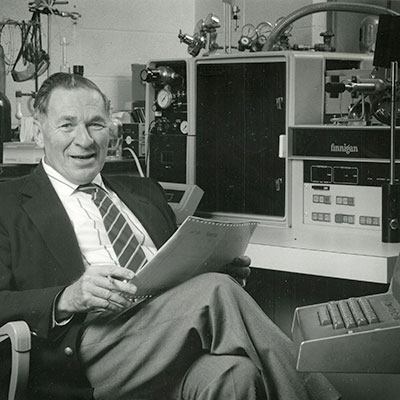The following paragraph is included in the supporting information of a recent Org. Lett. publication:
I (TRH, the corresponding author of this manuscript) share the following anecdote, which captures, in small part at least, some of the essence of Harold Heine’s (HWH’s) approach to teaching and mentoring. During our studies that culminated in the results described in ref 18 in the manuscript, I was asked by HWH to prepare a sample of 15N-labeled hydroxylamine-O-sulfonic acid (HASA, NH2OSO3H) for the (eventually incisive) mass spectrometry experiment. He suggested that before ordering the requisite 15NH2OH•HCl (ca. $600/0.5 g in 1972), I first convince us that I could prepare HASA with unlabeled material, which involved treating hydroxylamine with fuming sulfuric acid, filtering the precipitated solid, and washing it with ether. I did so with ease in January 1972. HWH ordered the labeled sample, which arrived several months later. He handed over the precious 15NH2OH•HCl with the suggestion that I practice repeating the preparation of 14NH2OSO3H once more, just to ensure that I had the details fresh in mind. Being an overly brash “senior investigator” (BS, Bucknell, 1972), I ignored that advice and proceeded to mix the 15NH2OH•HCl with oleum, just as I had done six months earlier. All was well until the white crystalline 15N-HASA substance, captured on the vacuum filtration funnel, turned to a soupy liquid in a matter of seconds and disappeared through the frit into the filtrate in irretrievable form. I had demonstrated that the highly hygroscopic HASA, a zwitterionic inner salt, was incompatible with the stifling humidity levels in the non-air-conditioned Bucknell laboratory in June of 1972. I reported to HWH the error of my ways, having ignored his advice, expecting a rather severe scolding ($600 was an entire student summer stipend at the time!). Instead of a tongue lashing, I received from him, after only a few seconds of his consideration of my confessional, “If I buy another sample for us, will you do it right this time?” What a (giant relief to me and) remarkable and formative example of the right way to react to a young researcher’s indiscretion. The take home lesson? Be tolerant of any mistake (at least the first time!) by a research student and, more broadly, by people in all walks of engagement. As for the eventual scientific bottom line here? See Figure S1 below [graphics extracted from ref 8 (= ref 1 in the manuscript)].
https://pubs.acs.org/doi/suppl/10.1021/acs.orglett.8b03439/suppl_file/ol8b03439_si_001.pdf
